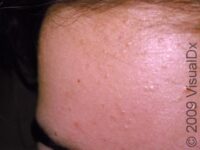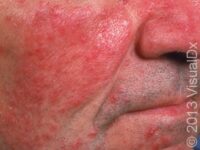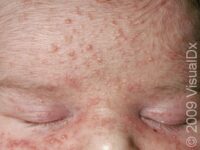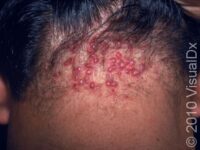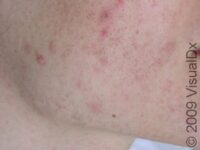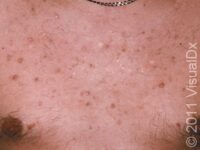
Acne and Acne-Like Conditions
Acne, also known as pimples, zits, and blemishes, is the term used for plugged pores (blackheads and whiteheads) and even deeper lumps (cysts, known as cystic acne) that occur on the face, neck, chest, back, shoulders, and even the upper arms. Acne affects most teens to some extent. (Close to 100% of people between the ages 12–17 have at least an occasional whitehead or blackhead.) However, the disease is not restricted to any age group; adults can also get acne. In fact, one fifth of women between the ages 25–40 suffer from adult acne. While acne is not a life-threatening condition, it can be upsetting and disfiguring.
There are many variations of acne, one of which is a condition known as acne mechanica. This form of acne results from chronic physical pressure on the skin, such as from the straps of a backpack or sports equipment. Acne excoriée is a form of acne resulting from the picking, squeezing, and rubbing of lesions, which result in scratches (excoriations). This type of acne is seen more commonly in women and usually starts during the teen years. There is commonly a history of acne, and the scratches may involve the face, neck, chest, breasts, back, and upper arms. Unfortunately, this picking can lead to acne scars and discoloration. Additionally, acne excoriée can result from the presence of anxiety, depression, or emotional distress. Acne keloidalis, which affects the hair follicles of black individuals, is usually located on the nape of the neck and associated with acne that heal with hard, raised scars (keloids). Sometimes similar scars can also be left from acne lesions on the chest, back, or face.
Some lesions that appear to be acne are not acne at all. One skin condition that resembles acne is folliculitis, which is inflammation caused by infection of the hair follicles.
Acne rosacea is a disorder affecting the middle portion of the face (mainly the forehead, chin, and lower half of the nose), which causes persistent redness. The tiny blood vessels in these areas enlarge and become more visible, appearing like tiny red lines (telangiectasias). The bumps of rosacea can resemble acne but, in fact, rosacea is different than acne. Unlike common acne, rosacea is not primarily a plague of teens but occurs most often in adults (ages 30–50), especially in those with fair skin. Additionally, unlike acne, there are no blackheads or whiteheads in rosacea.
To view different types of pictures of acne and learn more about acne treatment and skin care, click an image below.
